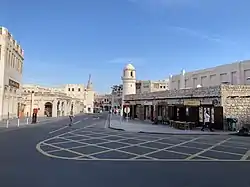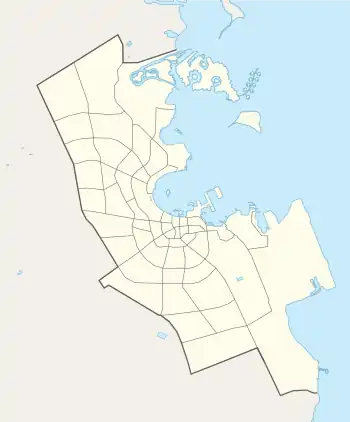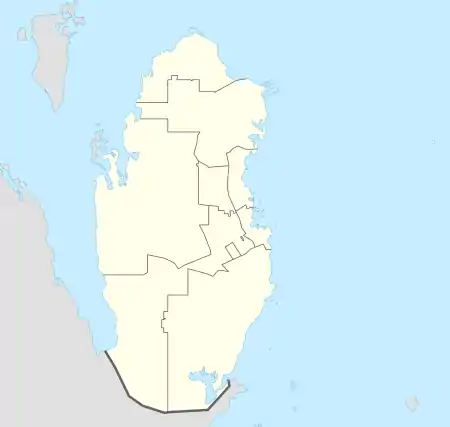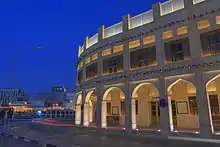Al Jasrah
Al Jasrah (Arabic: الجسرة) is a district in Qatar, located in the municipality of Ad Dawhah.
Al Jasrah
الجسرة | |
|---|---|
District | |
 A street lined with cafes in Souq Waqif | |
 Al Jasrah Location in Qatar  Al Jasrah Al Jasrah (Qatar) | |
| Coordinates: 25°17′10″N 51°32′3″E | |
| Country | |
| Municipality | Ad-Dawhah |
| Zone | Zone 1 |
| District no. | 1 |
| Area | |
| • Total | 0.2 sq mi (0.4 km2) |
| Population (2010) | |
| • Total | 240 |

It hosts Souq Waqif, one of the largest souqs in Qatar. Other points of interest in the district include Souq Jaidah, the Souq Waqif Falcon Hospital, the Souq Waqif Horse Stables, Abdul Aziz Nasser Theatre, Waqif Art Centre, Al Koot Fort (also known as Doha Fort) and Doha Fort Museum.[1]
Most of its landmarks are accessible through Al Souq Street, Souq Waqif Street and Al Jasra Street. To the immediate east of Al Jasrah is Al Souq, which hosts a number of smaller-sized souqs.[1]
Etymology
The meaning of "jasrah" in Arabic is "bridge". It was given this name because the partially submerged rocks along its coastline look like a bridge.[1]
History
Qatar's first hospital was established in Al Jasrah by emir Abdullah bin Jassim in 1947.[2]
In the 1980s Al Jasrah had the most expensive land in all of Qatar. The land price per ft² in 1981 was $171, this however decreased to $60 in 1988, which was still the highest price at that point in time.[3]
Geography
Al Jasrah borders the following districts:[1]
Administration
When free elections of the Central Municipal Council first took place in Qatar during 1999,[4] Al Jasrah was designated the constituency seat of constituency no. 1.[5] It would remain constituency seat in the next three consecutive elections until the fifth municipal elections in 2015.[6] In the inaugural municipal elections in 1999, Nasser Mohsen Mohammed Bokshisha won the elections, receiving 46.4%, or 356 votes.[5] Mohammed Abdel Aziz Mourad was elected in the 2002 elections.[7] For the third municipal elections in 2007, Tarek Saif Al-Malki was elected constituency representative.[8] Al-Malki successfully retained his seat in the 2011 elections.[9]
Historic landmarks

Nasser Al-Obaidan House
A house of the Al-Obaidan family that is located in the district is considered to be a local landmark. Constructed in the early-to-mid 20th century, the house is rectangular and measures 42 m by 31 m. It consists of two main structures which enclose a courtyard; one is shaped as an 'L' whereas the other runs parallel. The 'L' structure contains four rooms while the other structure accommodates seven rooms. There are some decorative features present, such as the shape of the roof parapet above the courtyard.[10]
Sheikh Hamad bin Abdullah House
A house belonging to a member of the ruling family, the building was constructed in 1930 and is noted for its lavish decorations. It consists of a two-storey structure which encloses a courtyard.[11]
Transport
Major roads that run through the district are Grand Hamad Street, Abdullah Bin Jassim Street, Jassim Bin Mohammed Street, and Corniche Street.[12]
Demographics
.jpg.webp)
As of the 2010 census, the district comprised 13 housing units[13] and 883 establishments.[14] There were 240 people living in the district, of which 99% were male and 1% were female. Out of the 240 inhabitants, 97% were 20 years of age or older and 3% were under the age of 20. The literacy rate stood at 99.2%.[15]
Employed persons made up 98% of the population. Females accounted for 0% of the working population, while males accounted for 100% of the working population.[15]
| Year | Population |
|---|---|
| 1986[16] | 1,291 |
| 1997[17] | 1,047 |
| 2004[18] | 827 |
| 2010[19] | 240 |
References
- "District map". The Centre for Geographic Information Systems of Qatar. Archived from the original on 24 November 2020. Retrieved 31 December 2018.
- "Timeline of Qatar". Museum With No Frontiers. Retrieved 31 August 2015.
- Fahd Abdul Rahmn Hamad Al-Thani (1992). "The Spatial Impact of the Hydrocarbon Industry on Land and Sea Use in Qatar" (PDF). University of Durham; Durham e-Thesis. p. 325.
- "Central Municipal Council". Government Communications Office of Qatar. Retrieved 14 August 2018.
- "إنتخابات الدورة الأولى" (in Arabic). Central Municipal Council. Archived from the original on 14 August 2018. Retrieved 14 August 2018.
- "مقـار الدوائـر" (in Arabic). Ministry of Interior (Qatar). Archived from the original on 14 August 2018. Retrieved 14 August 2018.
- "الدورة الثانية" (in Arabic). Central Municipal Council. Archived from the original on 14 August 2018. Retrieved 14 August 2018.
- "إنتخابات الدورة الثالثة" (in Arabic). Central Municipal Council. Archived from the original on 14 August 2018. Retrieved 14 August 2018.
- "رابعاً: إنتخابات الدورة الرابعة كشف بأسماء السادة المرشحين الفائزين في عضوية انتخابات المجلس البلدي المركزي (الدورة الرابعة - 2011م)" (in Arabic). Central Municipal Council. Archived from the original on 8 September 2019. Retrieved 14 August 2018.
- Jaidah, Ibrahim; Bourennane, Malika (2010). The History of Qatari Architecture 1800-1950. Skira. p. 108. ISBN 978-8861307933.
- Jaidah, Ibrahim; Bourennane, Malika (2010). The History of Qatari Architecture 1800-1950. Skira. p. 185. ISBN 978-8861307933.
- "Index map of Qatar". ArcGIS.com. Retrieved 25 August 2019.
- "Housing units, by type of unit and zone (April 2010)" (PDF). Qatar Statistics Authority. Archived from the original (PDF) on 8 July 2015. Retrieved 7 August 2015.
- "Establishments by status of establishment and zone (April 2010)" (PDF). Qatar Statistics Authority. Archived from the original (PDF) on 8 July 2015. Retrieved 7 August 2015.
- "Geo Statistics Application". Ministry of Development Planning and Statistics. Archived from the original on 2012-09-11. Retrieved 7 August 2015.
- "1986 population census" (PDF). Qatar Statistics Authority. Archived from the original (PDF) on 3 July 2015. Retrieved 2 July 2015.
- "1997 population census" (PDF). Qatar Statistics Authority. Archived from the original (PDF) on 29 May 2015. Retrieved 2 July 2015.
- "2004 population census". Qatar Statistics Authority. Archived from the original on 24 September 2015. Retrieved 1 July 2015.
- "2010 population census" (PDF). Qatar Statistics Authority. Archived from the original (PDF) on 2 April 2015. Retrieved 29 June 2015.